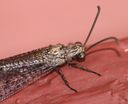Brachynemurus
Brachynemurus
Classification
- Phylum: Arthropoda
- Subphylum: Hexapoda
- Class: Insecta
- Order: Neuroptera
- Suborder: Myrmeleontiformia
- Family: Myrmeleontidae
- Subfamily: Myrmeleontinae
- Tribe: Brachynemurini
- Genus: Brachynemurus
Pronunciation
How to pronounce Brachynemurus: //ˌbrækɪnəˈmjʊrəs//
These audio files are automatically generated. While they are not always 100% accurate, they are a good starting point.
Images






Summary
Brachynemurus is a genus of antlions in the family Myrmeleontidae, encompassing 20 recognized species in North America, most of which are adapted to sandy environments.
Physical Characteristics
Body length 25-50 mm; large antlions with a soft, slender body and a long abdomen extending beyond wings; long wings with fine net-like venation.
Identification Tips
Species are closely similar; identification may require detailed examination of morphological features.
Habitat
Sandy areas.
Distribution
North America, especially south, with specific distributions including transcontinental and regional occurrences.
Diet
Adults feed on small insects.
Life Cycle
Adults are mostly nocturnal and larvae live in the sand, often leaving conspicuous trails.
Ecosystem Role
Predators of small insects in their habitat, playing a role in controlling insect populations.
Misconceptions
Confusion with closely related species due to morphological similarities.
Tags
- Brachynemurus
- antlion
- Myrmeleontidae
- insect
- neuroptera